When creating camouflage jackets, the choice of fabric is pivotal, balancing functionality, durability, and comfort. A camo jacket isn't just a fashion statement—it's often designed for outdoor activities, hunting, military purposes, or blending into natural surroundings. Therefore, selecting the right material ensures the jacket meets its intended purpose while maintaining style and usability.
Let’s explore the best fabrics use for making camo jackets!
Durability and Resilience: Cotton and Cotton Blends
Cotton and cotton blends are popular choices for cool camo jackets due to their durability and comfort. Pure cotton fabric is breathable, making it ideal for warmer climates or long outdoor sessions. When blended with synthetic fibers like polyester, cotton gains added strength, wrinkle resistance, and moisture-wicking properties. This hybrid material is excellent for crafting warm camo hunting jackets that can withstand tough environments while providing all-day comfort. Additionally, cotton blends are easy to dye, ensuring vibrant and lasting camouflage patterns.
Weather Resistance: Polyester and Nylon
Polyester and nylon are standout fabrics for military-style jackets intended for outdoor and military use. These materials are lightweight, water-resistant, and quick-drying, making them perfect for unpredictable weather conditions. Polyester offers superior resistance to UV rays, which helps maintain the camouflage print’s longevity. Nylon, on the other hand, is highly tear-resistant, making it ideal for rugged terrain. Both fabrics can be treated with additional coatings, like DWR (Durable Water Repellent), to enhance their weatherproofing properties.
Tactical Advantage: Ripstop Fabric
Ripstop fabric is a top contender for army camo jackets, especially for tactical and military applications. This fabric incorporates a grid of strong reinforcement threads woven into the material, preventing rips and tears from spreading. Whether you're navigating dense forests or crawling through rough terrain, ripstop fabric ensures your camo jacket holds up under stress. It’s available in both cotton and synthetic variations, offering flexibility to match specific needs.
Versatility in Style: Canvas and Twill
For army camo jackets with a stylish yet durable edge, canvas and twill are excellent choices. These heavier-weight fabrics provide structure and a premium feel, making them ideal for casual wear or urban settings. While not as lightweight as nylon or polyester, their robustness makes them a go-to for jackets designed to endure heavy use. Moreover, these fabrics can be treated for water resistance, further extending their versatility.
In conclusion, the ideal fabric for a camo jacket depends on its intended use. Cotton blends offer breathable comfort, synthetic fabrics excel in weather resistance, and ripstop adds unmatched durability for tactical applications. By choosing the right material, you ensure that your camo jacket not only looks great but performs flawlessly in its intended environment.


